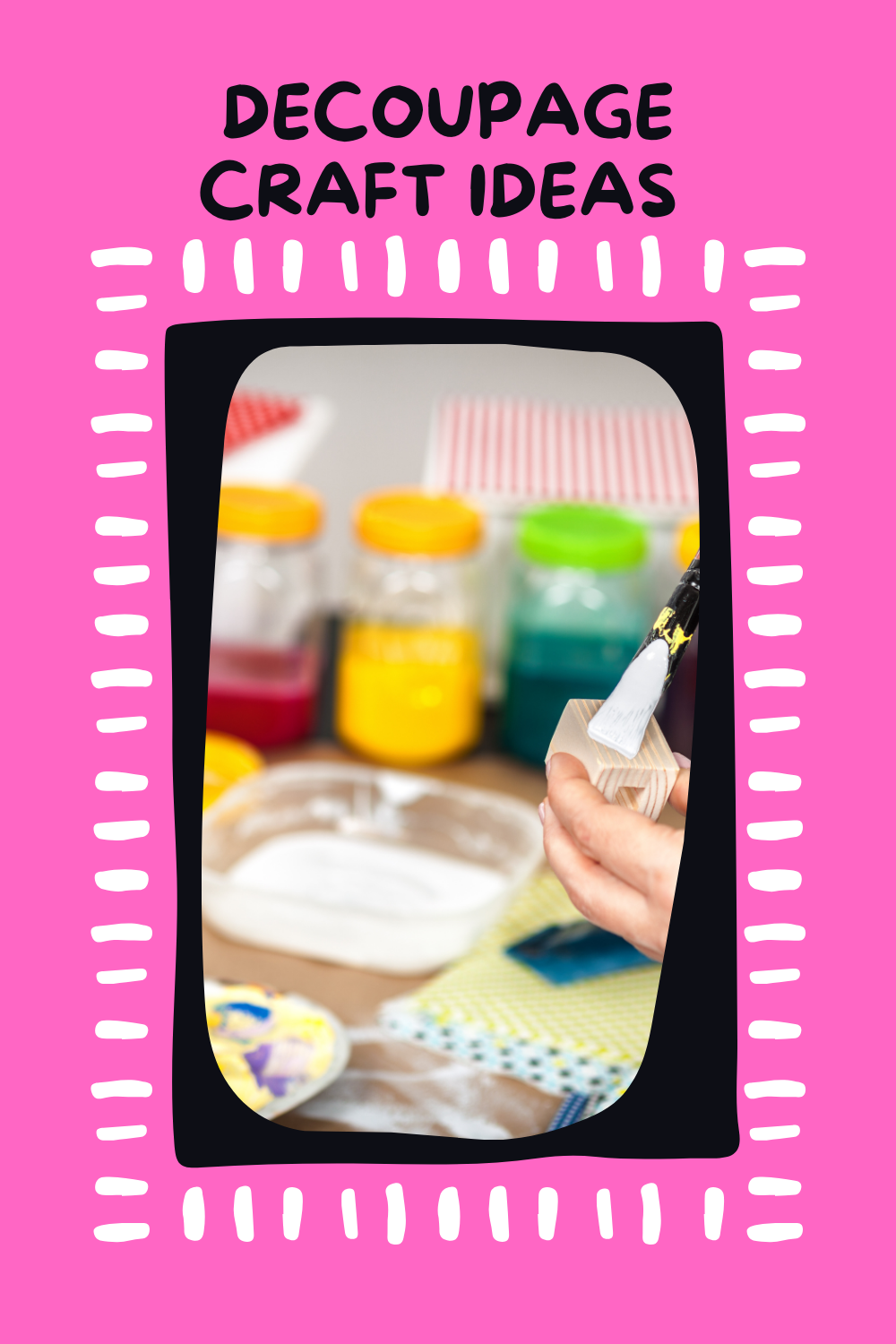Decoupage Coasters
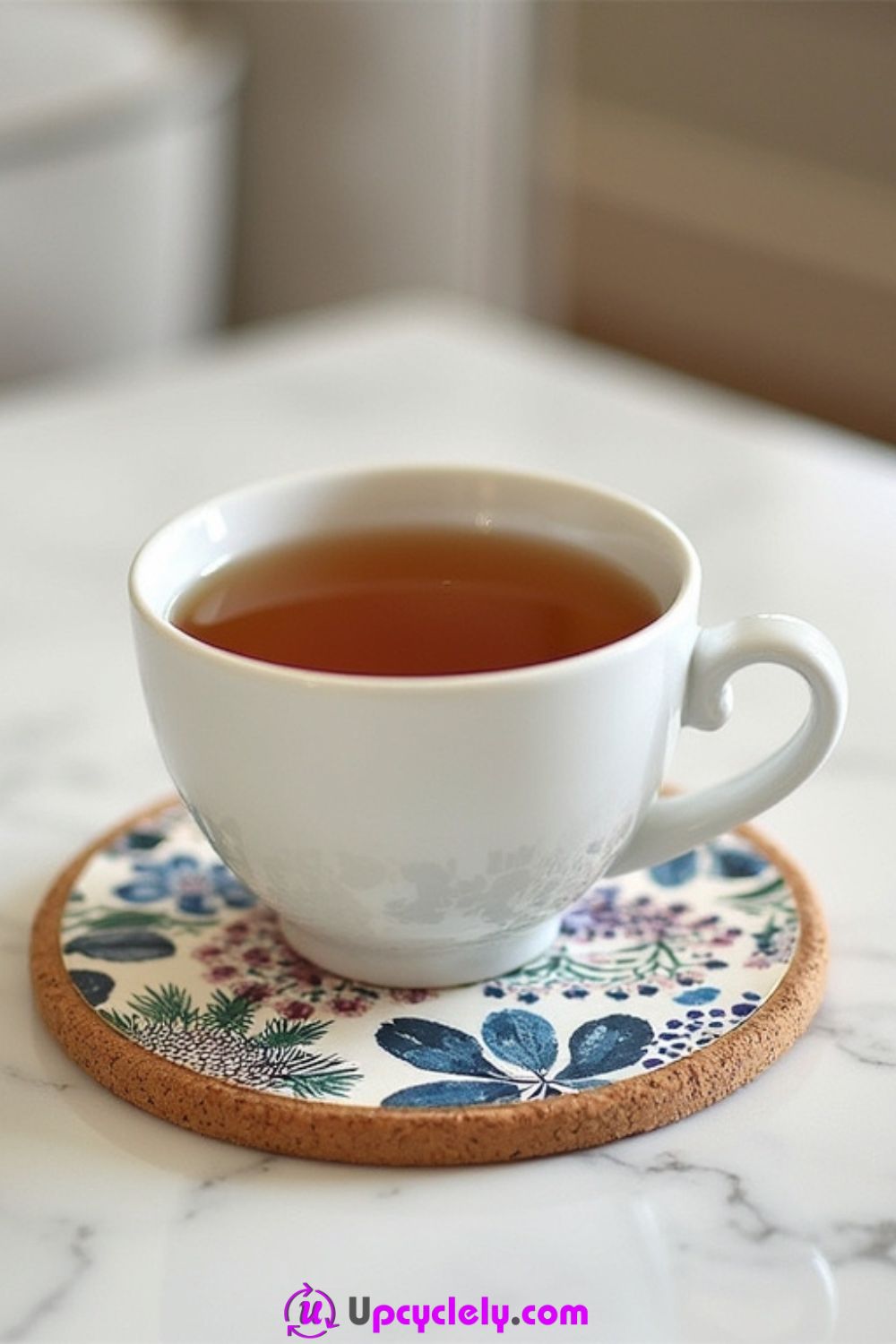
Materials Needed:
- Plain cork or ceramic coasters
- Mod Podge or decoupage glue
- Paintbrush or foam brush
- Printed paper with botanical designs (e.g., blue and green)
- Small scissors
- Acrylic sealant spray (optional)
- Ruler or pencil (optional for measuring)
Steps:
Step 1: Prepare the Coasters
I start by wiping down the cork or ceramic coaster with a dry cloth to remove dust or debris. If the coaster is ceramic, I might even sand it lightly to create a better surface for adhesion.
Step 2: Cut Your Design
Using my chosen botanical-themed paper, I measure and cut shapes to fit the coaster perfectly. If the design has specific flowers or patterns I want to showcase, I position my cutting around those areas.
Step 3: Apply the Design
I brush a thin, even layer of Mod Podge onto the coaster’s surface using a foam brush. Then, I carefully place my cut paper on top, smoothing out any air bubbles or creases with my fingers or a credit card.
Step 4: Seal and Finish
Once the design is in place, I apply two to three coats of Mod Podge over the paper, letting each layer dry completely. For added durability, I spray the coaster with an acrylic sealant to make it water-resistant.
Pro Tip:
I always use a damp cloth to gently press down the paper while removing bubbles. This prevents tears in delicate designs and ensures an even finish.
Decoupage Bookmarks
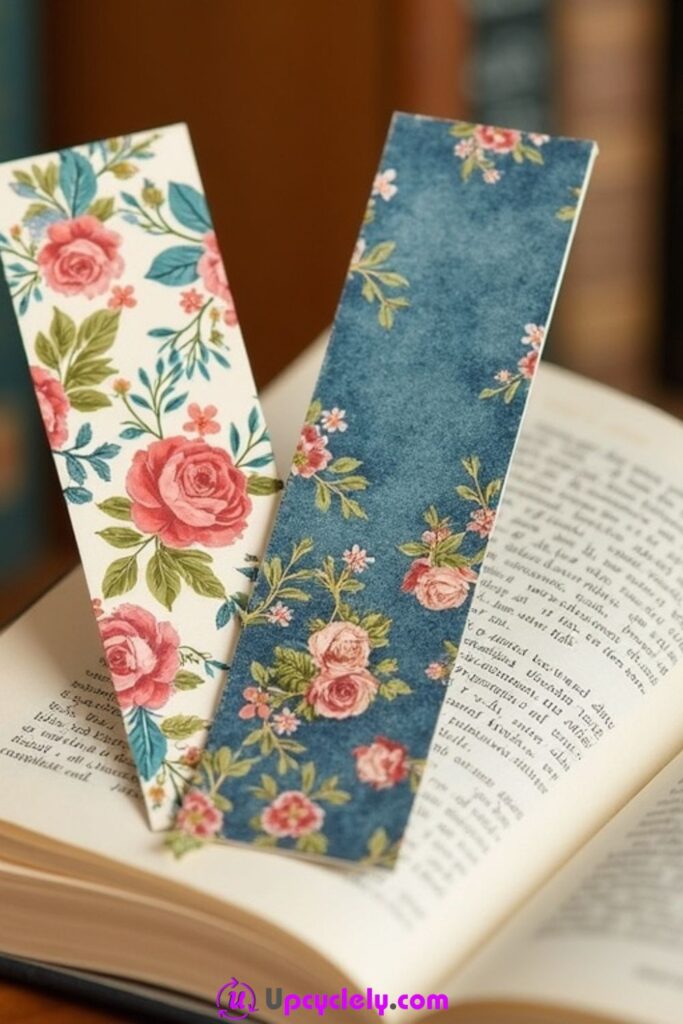
Materials Needed:
- Plain card or wooden bookmarks
- Decorative floral paper or tissue paper
- Mod Podge or decoupage glue
- Paintbrush
- Hole puncher
- Ribbon or tassels (optional)
Steps:
Step 1: Prepare the Base
If I am using card stock or wood as my base, I make sure it has smooth edges. Sometimes I sand wooden bookmarks for a polished look before starting.
Step 2: Cut the Paper
Since I want every bookmark to stand out, I carefully cut paper with designs like roses, leaves, or abstract patterns to match the bookmark’s size. Having multiple colors like cream and blue adds a nice variation.
Step 3: Stick and Smooth
I brush Mod Podge onto the surface of the bookmark and lay my selected paper on it. Using my fingers, I smooth out wrinkles for a seamless appearance.
Step 4: Seal and Add a Touch of Elegance
I seal the design with several layers of Mod Podge. After everything dries, I punch a hole at the top and attach a ribbon or tassel for a decorative finish.
Pro Tip:
Mix and match different patterns on a single bookmark for a creative patchwork look. Overlapping designs can create a unique, artistic element!
Decoupage Candle Holders
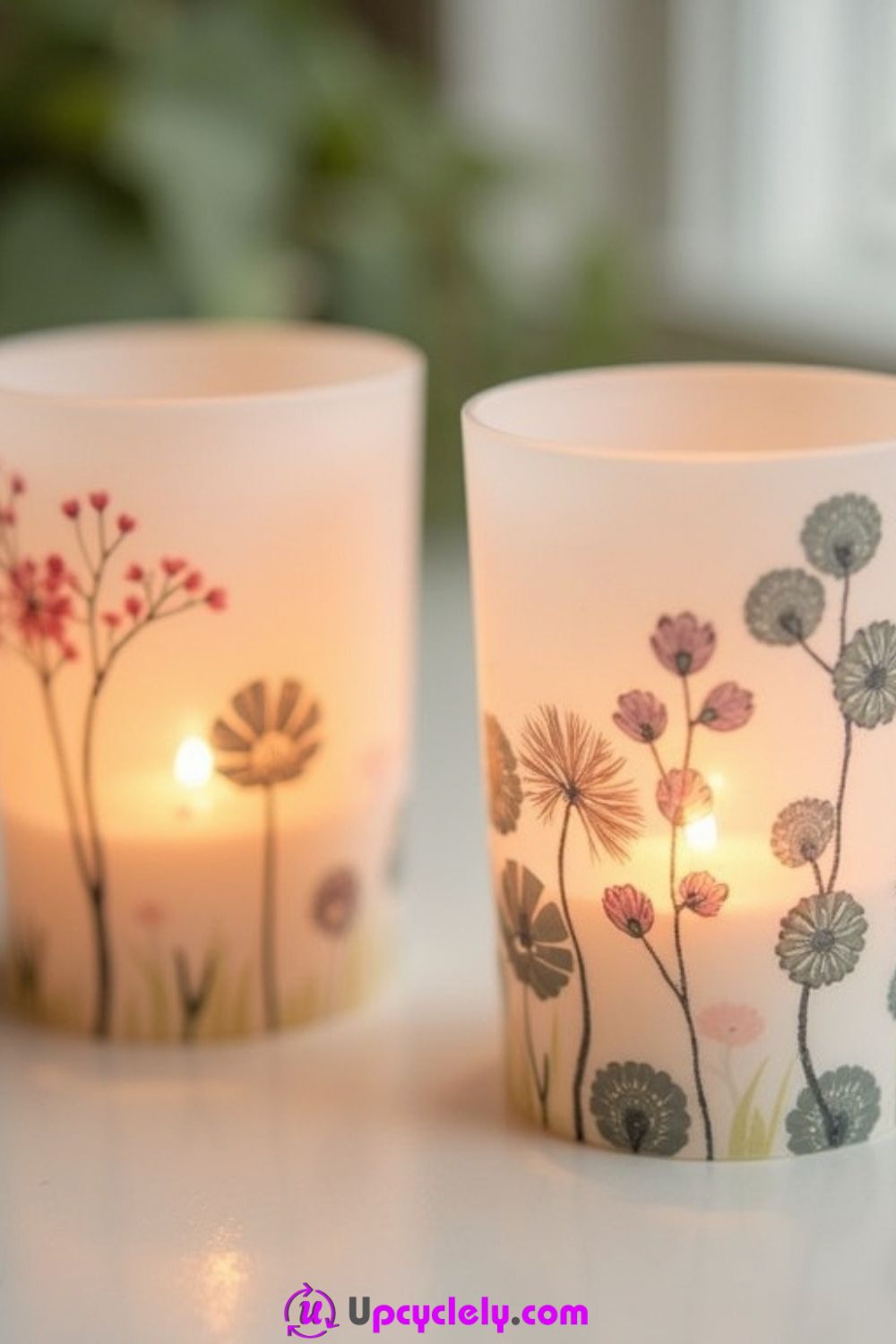
Materials Needed:
- Frosted glass candle holders
- Printed tissue paper with floral designs
- Mod Podge or decoupage glue (matte finish works well)
- Soft paintbrush
- Small scissors
Steps:
Step 1: Prepare the Candle Holders
I wipe the frosted glass holders with a damp cloth to ensure they’re clean. A smooth, clean surface helps the paper adhere better.
Step 2: Select and Cut the Designs
Using delicate tissue paper with floral patterns, I choose sections with red blossoms or dandelions to suit my preference. I trim these carefully with small scissors to fit the candle holder’s size.
Step 3: Apply the Tissue Paper
I brush a thin layer of Mod Podge onto the glass and carefully place my cutout tissue paper on it. I work gently to avoid tearing the fragile paper, making sure to smooth it down with my fingers.
Step 4: Seal and Display
After everything is dry, I apply one or two thin coats of Mod Podge over the tissue paper to seal it in place. This ensures longevity while retaining the frosted aesthetic.
Pro Tip:
When lit, the candle creates a warm, ambient glow through the floral tissue paper. Selecting lighter, transparent designs enhances this effect beautifully.
Decoupage Canvas Shoes
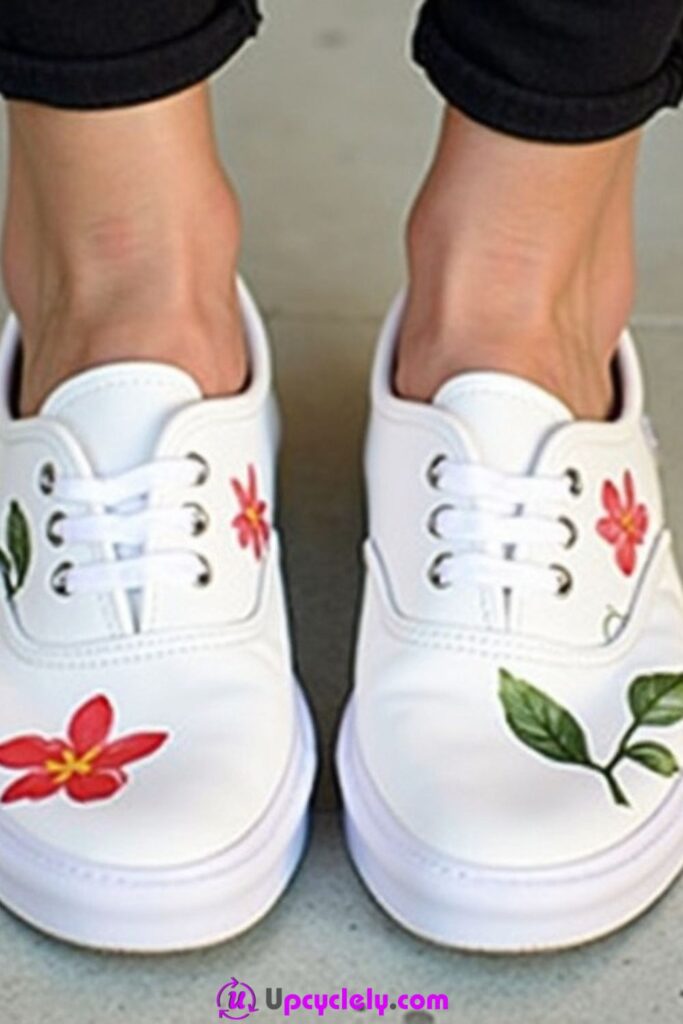
Materials Needed:
- Plain white canvas sneakers
- Mod Podge (fabric formula if available)
- Printed floral fabric or paper
- Sharp scissors
- Soft bristle paintbrush
- Masking tape (optional)
Steps:
Step 1: Prepare the Shoes
I clean the sneakers to remove dust and use masking tape to shield any parts I don’t want to decoupage, like the rubber soles and laces.
Step 2: Cut the Fabric or Paper
After picking out small, colorful floral patterns, I carefully cut the fabric or paper to fit areas of the shoes, such as the sides, toe area, or even the tongue for added flair.
Step 3: Attach Your Design
I paint a thin, even coat of Mod Podge on the target area and press the fabric or paper onto it. I take my time to ensure it sticks well, smoothing out any wrinkles.
Step 4: Seal and Customize
I top it with another coat of Mod Podge for durability and allow it to dry for 24 hours. Once dry, I remove the masking tape and lace up the shoes for a completely unique, vibrant look.
Pro Tip:
Using fabric instead of paper ensures flexibility and durability for shoes. It won’t tear as easily when the shoes bend.
Decoupage Christmas Ornaments
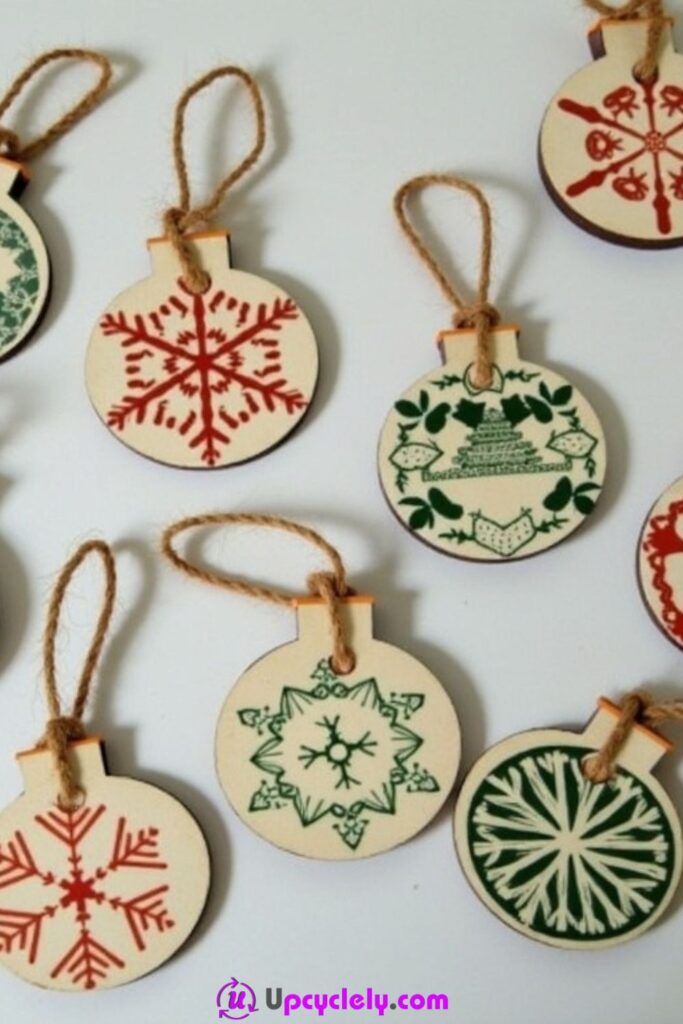
Materials Needed:
- Plain wood or plastic ornaments
- Holiday-themed tissue paper or napkins
- Mod Podge (glossy finish for a festive look)
- Paintbrush
- Twine for hanging
- Small craft knife or detail scissors
Steps:
Step 1: Clean and Prep the Ornaments
I make sure the ornaments are free from dust. For wooden ones, I sand the surface lightly for better adhesion.
Step 2: Cut the Designs
I use festive napkins or tissue paper featuring snowflakes, holly, or geometric patterns. I cut them to sizes that cover the ornament’s surface.
Step 3: Adhere the Paper
I brush a layer of Mod Podge onto the ornament’s surface and carefully lay the paper over it. Slowly, I smooth out wrinkles with my fingers or a soft cloth.
Step 4: Finishing Touches
After sealing the paper with another coat of Mod Podge, I attach twine for hanging. Once everything is dry, I step back to admire my custom holiday decorations.
Pro Tip:
For a more dimensional and intricate look, layer smaller designs over a base pattern on the ornament.s outline with one backstitch layer around the large heart. This provides a polished border that enhances the motif.
Decoupage Picture Frames
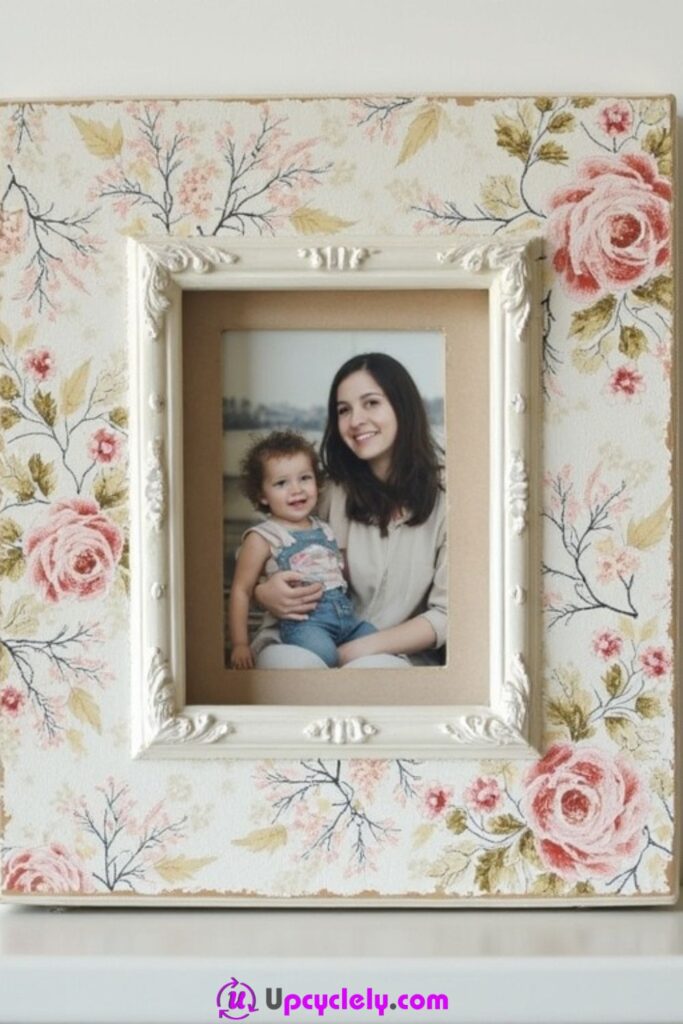
Materials Needed:
- Picture frame (wood or plastic)
- Decorative paper (e.g., floral patterns)
- Mod Podge or decoupage glue
- Scissors
- Paintbrush
- Sandpaper (optional)
Step 1: Prepare the Frame
Start by cleaning your picture frame. If it’s wooden, lightly sand it to smooth out any rough spots. This will help the decoupage glue stick better and give your project a polished look.
Step 2: Cut Out Paper Pieces
Choose decorative paper that suits the theme you’re going for. You can use floral patterns or any design that you love. Cut the paper into pieces, making sure the edges will fit nicely around the frame’s borders. You can mix and match different sections of paper for a more artistic effect.
Step 3: Apply the Paper
Using a paintbrush, apply a thin layer of decoupage glue (Mod Podge) onto the frame. Place your paper pieces on the glue, smoothing them out with your fingers or a flat object to avoid wrinkles. Continue until the entire frame is covered, being sure to layer the paper pieces over one another where needed.
Step 4: Seal the Frame
Once the paper is dry, apply a coat of Mod Podge over the entire frame to seal the decoupage. Allow it to dry completely. You can add additional coats for extra durability, letting each coat dry before applying the next.
Pro Tip: If you’re using a glossy frame, a matte finish on top of the decoupage will give a more subtle look and prevent the frame from looking too shiny.
Decoupage Furniture Handles
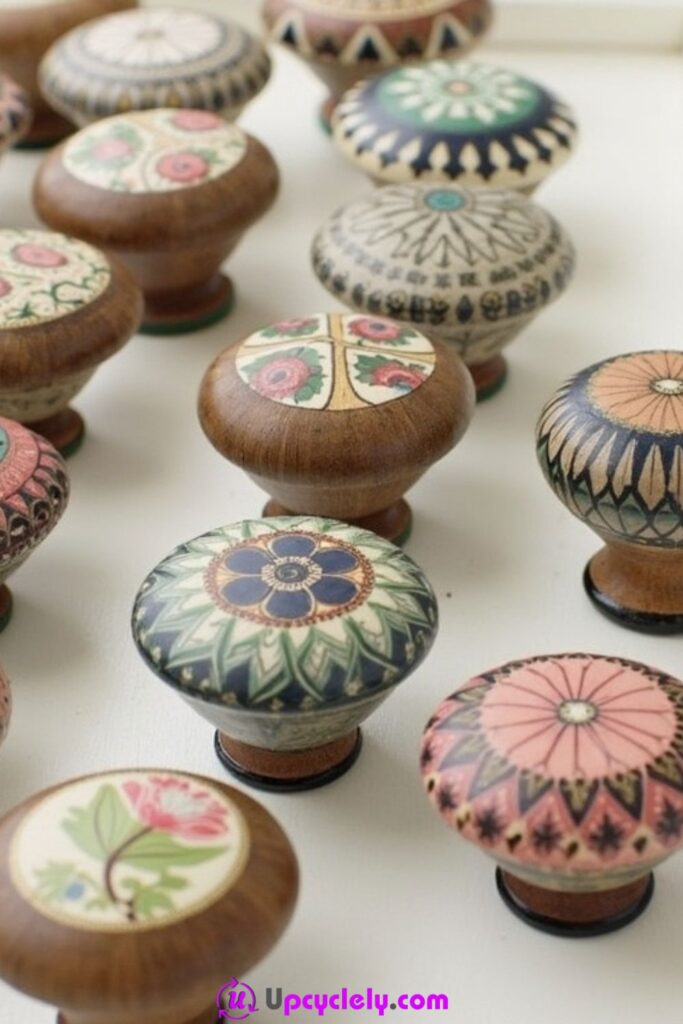
Materials Needed:
- Wooden or metal handles
- Decorative paper (vintage floral or intricate designs)
- Scissors
- Decoupage glue (Mod Podge)
- Paintbrush
- Clear acrylic sealer (optional)
Step 1: Remove the Handles
Take off the furniture handles from the drawers or cabinet doors before beginning the decoupage process. This will make it easier to work on them without damaging the surrounding furniture.
Step 2: Cut the Paper
Select a piece of decorative paper that fits the shape and size of your handle. Measure the area you want to cover and cut your paper accordingly. Be sure to leave a little excess on the edges for wrapping around.
Step 3: Apply the Paper
Brush a thin layer of decoupage glue onto the handle. Gently place your paper over the glue, smoothing it with your fingers or a tool like a bone folder to get rid of any bubbles. Wrap the paper around the handle and trim off any excess.
Step 4: Seal the Paper
Once the glue is dry, apply another layer of decoupage glue to seal the paper in place. Let it dry thoroughly. For extra durability, apply a clear acrylic sealer to protect the paper and ensure it lasts longer.
Pro Tip: If you want to create a more textured look, consider using a patterned tissue paper for a more distressed effect.
Decoupage Glass Jars
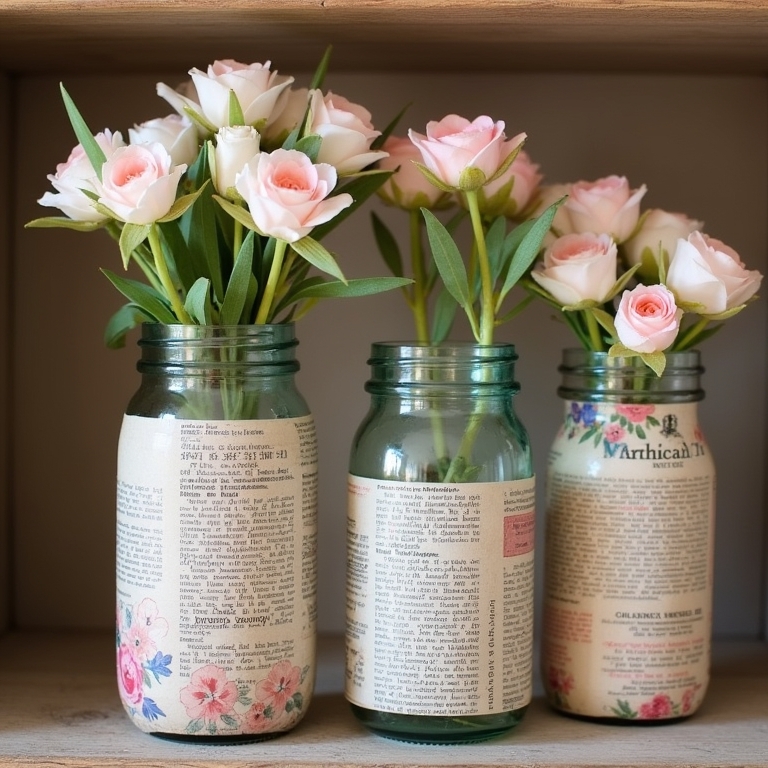
Materials Needed:
- Empty glass jars
- Decorative paper or napkins (floral or vintage)
- Mod Podge or decoupage glue
- Scissors
- Paintbrush
Step 1: Clean the Jars
Before starting, wash the glass jars thoroughly to remove any labels or adhesive. Dry them completely to ensure the glue sticks well.
Step 2: Cut the Paper
Choose your decorative paper and cut it into strips or pieces that will fit the jar. For a more intricate design, consider using napkins with layered patterns that can be peeled apart for a delicate look.
Step 3: Apply the Paper
Apply a layer of Mod Podge to the glass surface. Carefully apply the paper, smoothing out any wrinkles as you go. Be sure to wrap the paper tightly around the jar if you’re going for a full-cover design, or place pieces strategically for a more patchwork effect.
Step 4: Seal and Dry
Once the paper is applied, brush another layer of Mod Podge over the surface to seal the design. Allow the jars to dry completely. You can add more coats if necessary for a smoother finish.
Pro Tip: For an extra touch, consider adding decorative twine or lace around the neck of the jar to complete the look.
Decoupage Greeting Cards
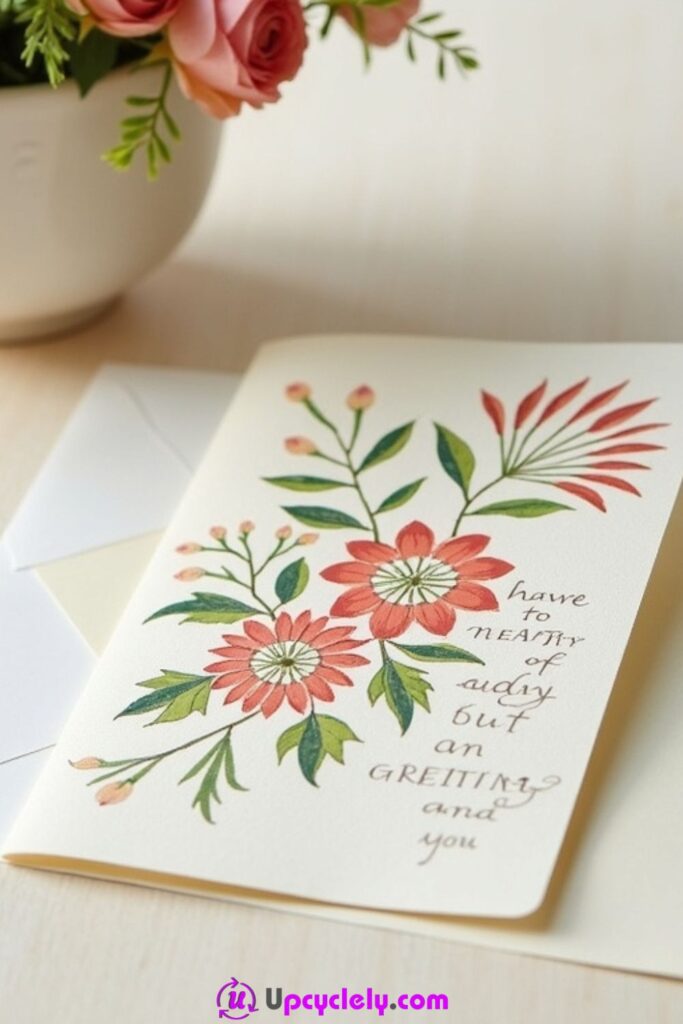
Materials Needed:
- Blank greeting cards
- Decorative paper or vintage images
- Scissors
- Mod Podge or decoupage glue
- Paintbrush
- Card stock for backing (optional)
Step 1: Select Your Design
Choose a decorative paper or vintage images that you want to use on your greeting card. It could be anything from floral motifs to whimsical designs. Cut out the elements you want to add to the card.
Step 2: Apply the Paper
Lightly brush decoupage glue onto the card where you want to place your design. Gently press the cut pieces of paper onto the card, smoothing them out as you go.
Step 3: Secure and Seal
Once the paper pieces are in place, apply a thin layer of decoupage glue over the entire design. This will seal the paper and give it a smooth finish.
Step 4: Dry and Finish
Allow the card to dry. Once dried, you can further embellish the card with additional decorations or messages.Pro Tip: For a pop of color, you can add ribbons or washi tape to the edges of the card for a more personalized touch.
Decoupage Jewelry Boxes
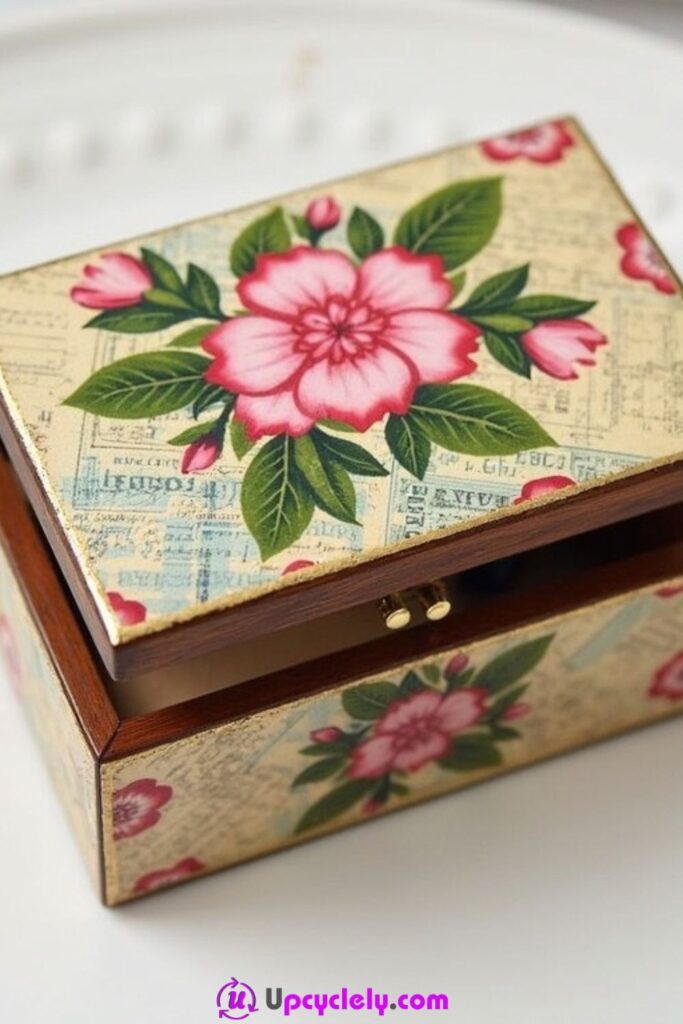
Materials Needed:
- Wooden jewelry box
- Decorative paper (floral, vintage, or textured patterns)
- Mod Podge or decoupage glue
- Scissors
- Paintbrush
- Clear sealer
Step 1: Prepare the Box
Clean the surface of the jewelry box and sand it lightly if necessary. This ensures that the decoupage glue will adhere properly.
Step 2: Cut the Paper
Select the decorative paper and cut it into shapes or strips to fit the surface area of the box. If the box has multiple sections, you might want to cut smaller pieces to fit those as well.
Step 3: Apply the Paper
Use a paintbrush to apply a thin layer of decoupage glue to the surface of the jewelry box. Place the paper carefully, smoothing it down to avoid any air bubbles or wrinkles.
Step 4: Seal the Design
Once the paper is applied and dried, apply a thin coat of decoupage glue over the paper to seal it. Let it dry completely before applying a clear acrylic sealer for added protection.
Pro Tip: To add a little sparkle to your box, consider sprinkling glitter over the wet glue layer before sealing it.
Decoupage Light Switch Covers
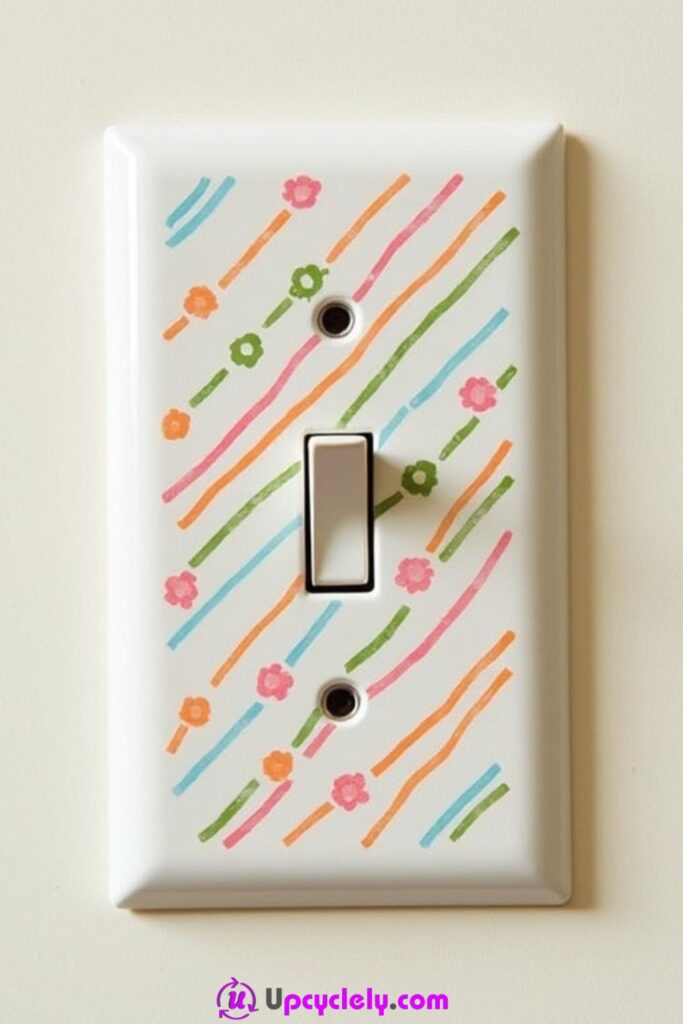
Materials Needed:
- Light switch cover (plastic or metal)
- Decorative paper (floral patterns or vibrant colors)
- Scissors
- Mod Podge or decoupage glue
- Paintbrush
- Clear acrylic sealer
Step 1: Remove the Light Switch Cover
Start by carefully removing the light switch cover from the wall. This makes it easier to apply the decoupage and prevents getting glue on the wall or surrounding areas.
Step 2: Prepare the Paper
Cut the decorative paper to fit the light switch cover, leaving a little extra around the edges. You can mix and match patterns or use a single bold design.
Step 3: Apply the Paper
Brush a thin layer of decoupage glue onto the surface of the cover. Gently apply the paper, smoothing out wrinkles or air bubbles with your fingers or a flat object like a bone folder.
Step 4: Seal and Dry
Once the paper is applied, brush another layer of decoupage glue on top to seal it. Let the cover dry completely. For extra durability, apply a clear acrylic sealer to protect the paper and prevent wear.
Pro Tip: If you’re using patterned paper, be mindful of the placement to ensure the design aligns well. You may want to use a grid pattern to help you line it up straight.
Decoupage Magazine Holders
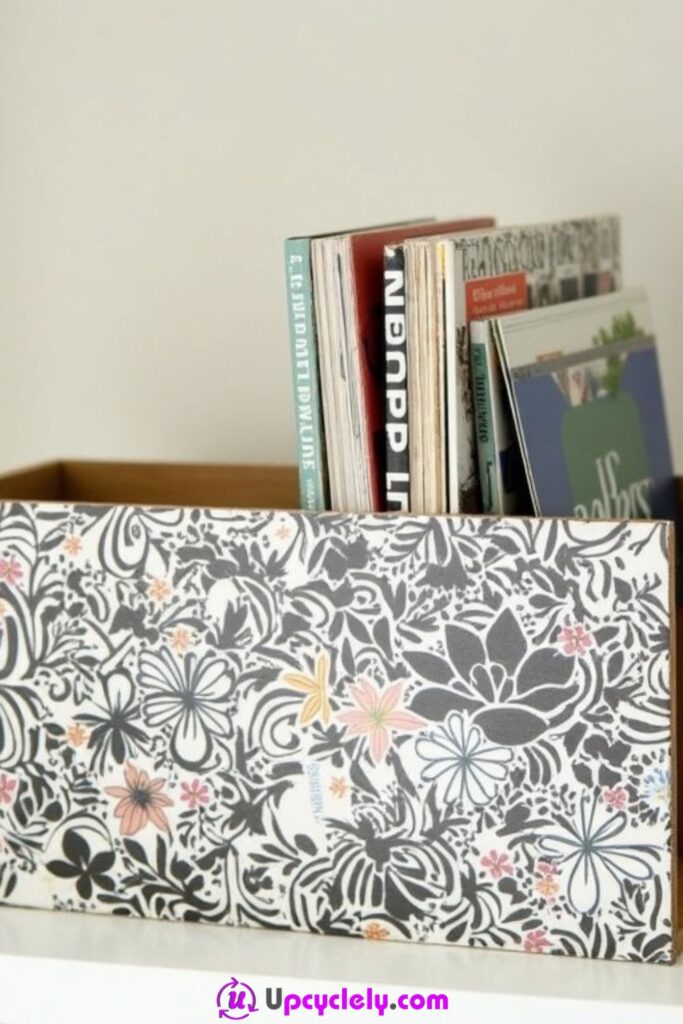
Materials Needed:
- Cardboard magazine holder
- Decorative paper (bold or vintage patterns)
- Scissors
- Mod Podge or decoupage glue
- Paintbrush
Step 1: Prepare the Holder
Take your magazine holder and make sure it’s clean. If you’re working with a plain cardboard one, ensure it’s smooth and ready to be covered with paper.
Step 2: Cut the Paper
Cut your chosen decorative paper into pieces that will fit each side of the magazine holder. You might want to cut slightly larger pieces to cover the edges and then trim off any excess once it’s in place.
Step 3: Apply the Paper
Brush a thin layer of decoupage glue on one side of the holder. Start placing the paper on top, smoothing it as you go to avoid air bubbles. Repeat this process for all sides of the holder.
Step 4: Seal the Design
Once the paper is applied and dry, coat the entire surface with a layer of decoupage glue to seal it. Let it dry thoroughly, and consider applying a clear acrylic sealer to protect the surface.
Pro Tip: If the edges of your paper are frayed or lifting, consider using a decorative tape to finish off the edges for a clean and polished look.
Decoupage Mirrors
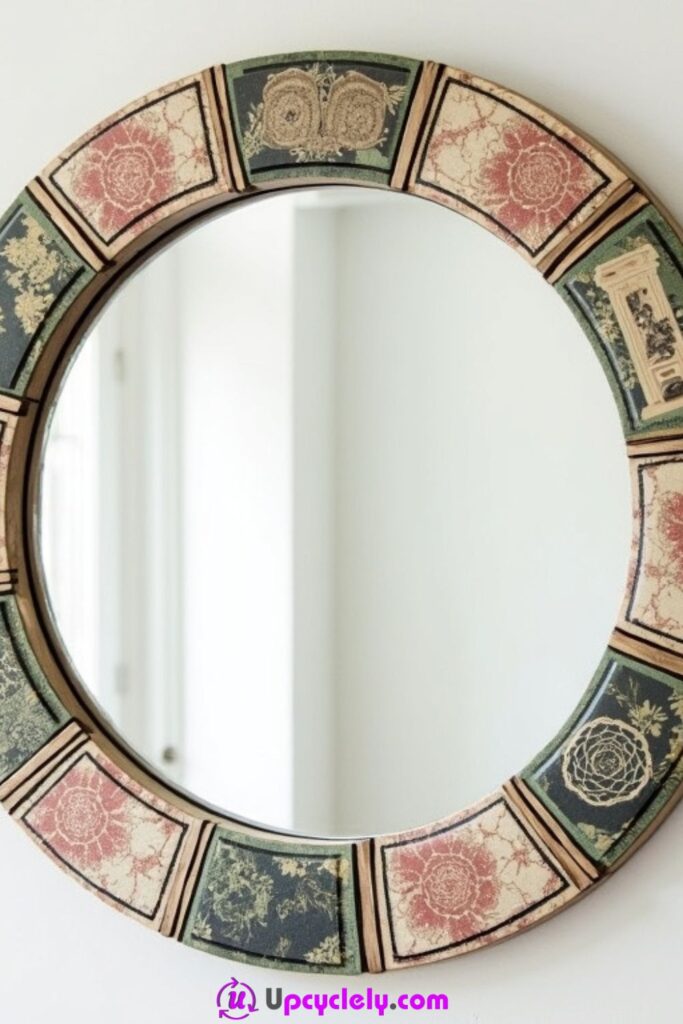
Materials Needed:
- Round or rectangular mirror with a simple frame
- Decorative paper (floral, vintage, or abstract patterns)
- Scissors
- Mod Podge or decoupage glue
- Paintbrush
- Clear acrylic sealer (optional)
Step 1: Prepare the Mirror Frame
Ensure the frame is clean and dry. If it’s a plastic or wooden frame, sand it lightly to ensure the glue sticks well. Be careful not to get glue on the glass mirror itself.
Step 2: Cut the Paper
Cut your decorative paper into pieces that will fit around the frame. You can use small paper pieces for a patchwork effect or larger pieces for a more uniform look.
Step 3: Apply the Paper
Apply a layer of decoupage glue on the frame and gently place the paper. Smooth the paper out with your fingers, removing any bubbles or wrinkles. If necessary, trim any excess paper from the edges once it’s applied.
Step 4: Seal and Finish
After the paper is applied and dried, brush another layer of decoupage glue to seal the paper. Let it dry completely, and if desired, finish with a clear acrylic sealer for extra durability.
Pro Tip: To give the mirror a more luxurious look, you can use metallic or gold leaf paper around the edges for a striking contrast against floral designs.
Decoupage Notebooks
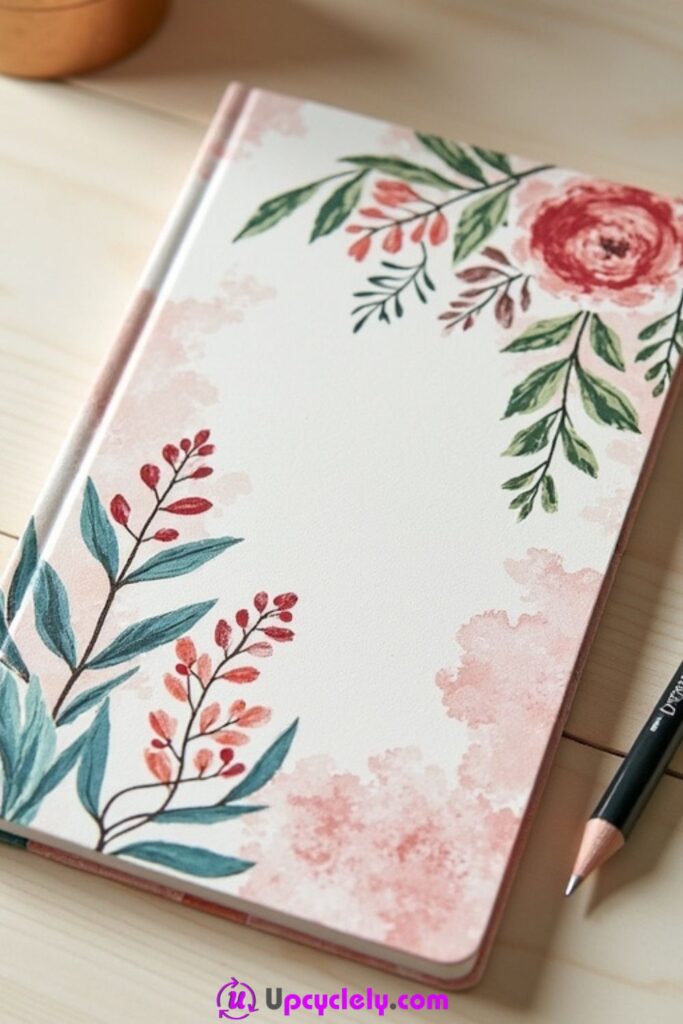
Materials Needed:
- Blank notebook (preferably with a cardboard or hardcover)
- Decorative paper (floral or abstract patterns)
- Scissors
- Mod Podge or decoupage glue
- Paintbrush
Step 1: Prepare the Notebook
If your notebook has a plastic cover, consider removing it before beginning. For a hardcover notebook, simply wipe it clean to ensure a smooth surface for applying the paper.
Step 2: Cut the Paper
Cut the decorative paper to match the size of your notebook cover. Be sure to leave extra around the edges to wrap it under the notebook cover.
Step 3: Apply the Paper
Brush a thin layer of decoupage glue over the notebook cover. Carefully place the decorative paper over the glue and smooth it out to eliminate any air bubbles.
Step 4: Seal the Paper
Once the paper is applied, coat the entire surface with another layer of decoupage glue. Let it dry completely, and apply a clear acrylic sealer for extra protection if desired.
Pro Tip: You can add additional embellishments like ribbon, buttons, or stickers to make the notebook even more personalized and unique.
Decoupage Pen Holders
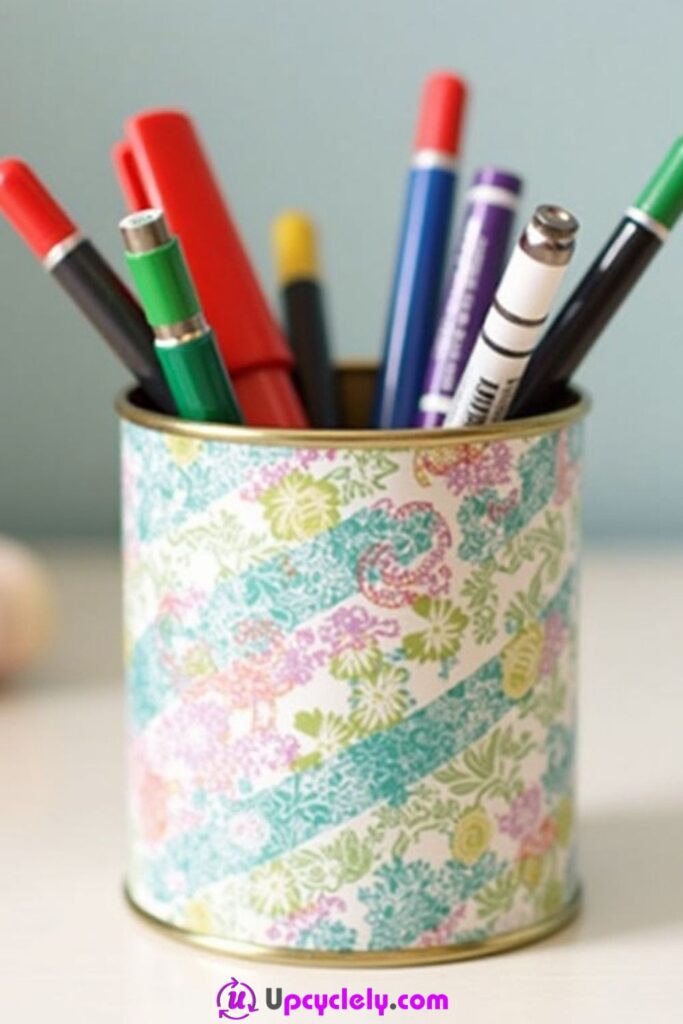
Materials Needed:
- Tin can or small container
- Decorative paper (floral, geometric, or playful designs)
- Scissors
- Mod Podge or decoupage glue
- Paintbrush
Step 1: Prepare the Container
Take a clean, empty tin can or any small container that you’d like to turn into a pen holder. Remove any labels and wash the can thoroughly before beginning the decoupage.
Step 2: Cut the Paper
Cut your decorative paper into strips or pieces that will fit around the can. You can wrap the paper completely around the container or create a patchwork effect with different designs.
Step 3: Apply the Paper
Brush a thin layer of decoupage glue on the surface of the container and apply the paper, smoothing it with your fingers. Continue this process until the entire container is covered.
Step 4: Seal and Dry
Once all the paper is applied, coat the surface with a layer of decoupage glue to seal it. Allow it to dry completely, and you can add an optional clear acrylic sealer for a more durable finish.
Pro Tip: Add some flair to your pen holder by gluing on small decorative items such as buttons or beads for a more creative look.
Decoupage Wooden Spoons
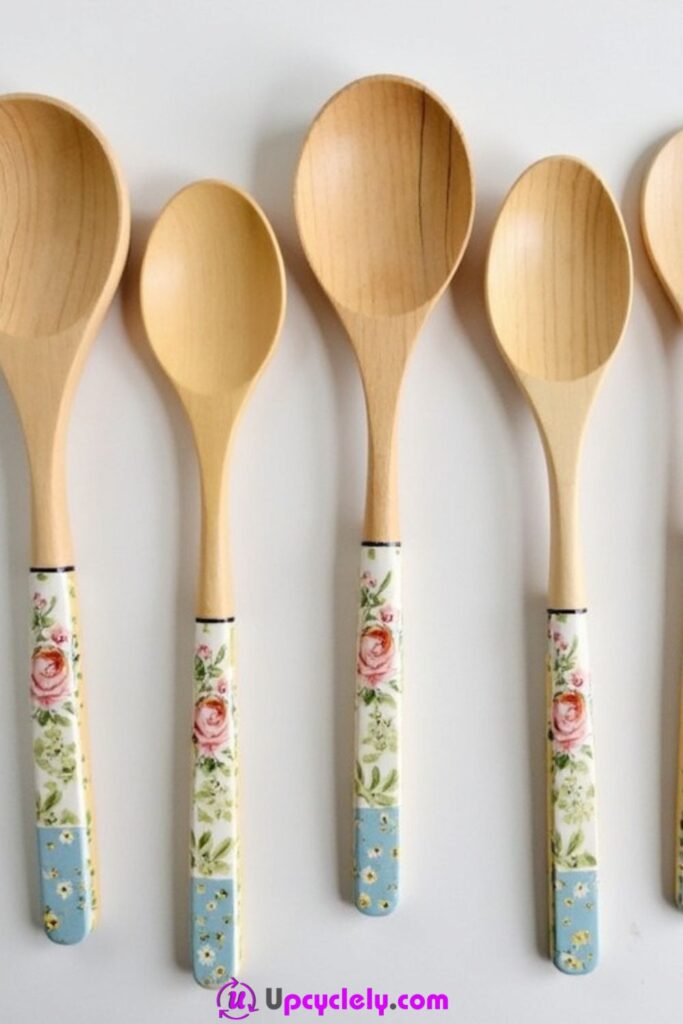
Materials Needed:
- Wooden cooking spoons
- Floral or patterned decorative paper
- Scissors
- Mod Podge or decoupage glue
- Paintbrush
- Sandpaper (optional)
Step 1: Prepare the Spoons
Start by cleaning the wooden spoons thoroughly. If they are rough, lightly sand them to smooth out the surface. This helps the decoupage glue to adhere better.
Step 2: Cut the Paper
Cut your decorative paper into strips or pieces that will fit the handles of the spoons. You can go for a simple floral pattern, like roses and leaves, or a more vibrant design, depending on your style.
Step 3: Apply the Paper
Brush a thin layer of decoupage glue onto the spoon handles. Carefully apply your paper pieces, smoothing them out as you go to avoid wrinkles. Wrap the paper around the spoon handles, ensuring that it sticks well.
Step 4: Seal and Dry
Once the paper is in place, apply another layer of decoupage glue on top to seal it. Let it dry completely before using the spoons. You can add an additional coat for extra durability.
Pro Tip: If you plan to use these spoons for cooking, consider sealing them with a food-safe sealer after applying the decoupage for added protection.
Decoupage Shoe Boxes
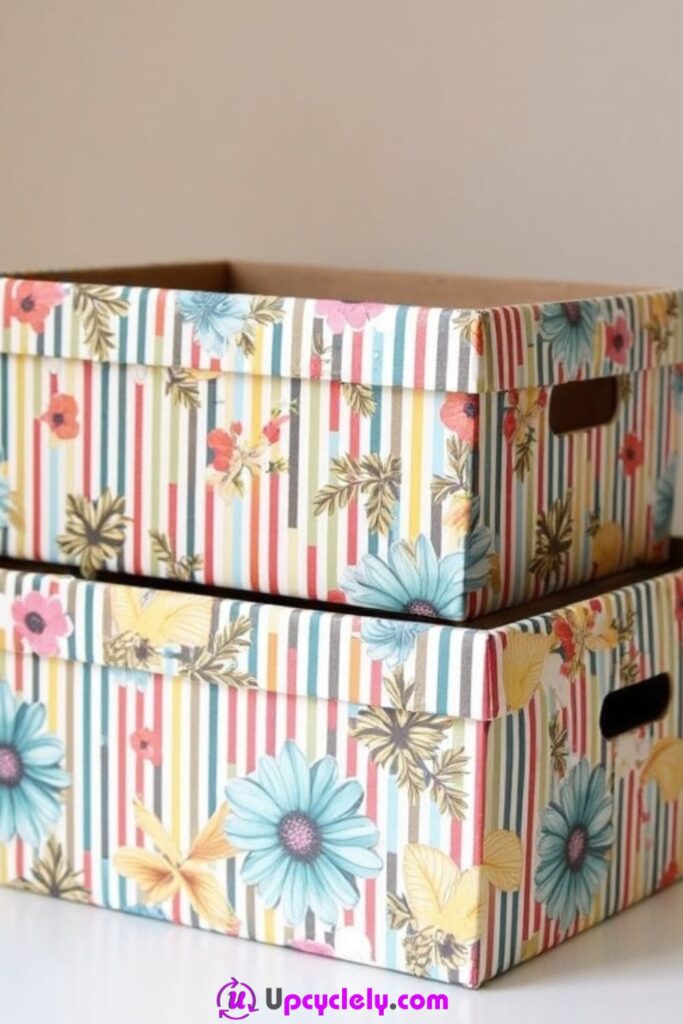
Materials Needed:
- Cardboard shoe boxes
- Colorful striped or floral paper
- Scissors
- Mod Podge or decoupage glue
- Paintbrush
- Craft knife (optional)
Step 1: Prepare the Shoe Box
Remove any labels or stickers from the shoe box. If the box is creased, you can smooth it out with your hands or a craft knife to ensure a clean surface for the decoupage.
Step 2: Cut the Paper
Cut your decorative paper into pieces that will fit the box’s surfaces. For a striped box, cut straight strips; for floral patterns, you can cut individual flowers or larger patches to create a patchwork effect.
Step 3: Apply the Paper
Apply a thin layer of decoupage glue to the surface of the box. Position your paper pieces, smoothing them with a paintbrush or your fingers to ensure they stick well. If you’re using a patterned paper, make sure the pattern aligns neatly for a more cohesive look.
Step 4: Seal and Finish
Once you have covered the box, brush a final layer of decoupage glue over the surface. Let it dry completely. If you want extra durability, you can apply a clear acrylic sealer for a more polished finish.
Pro Tip: Add some decorative handles or embellishments like ribbons to give the shoe box a more elegant look.
Decoupage Tissue Box Cover
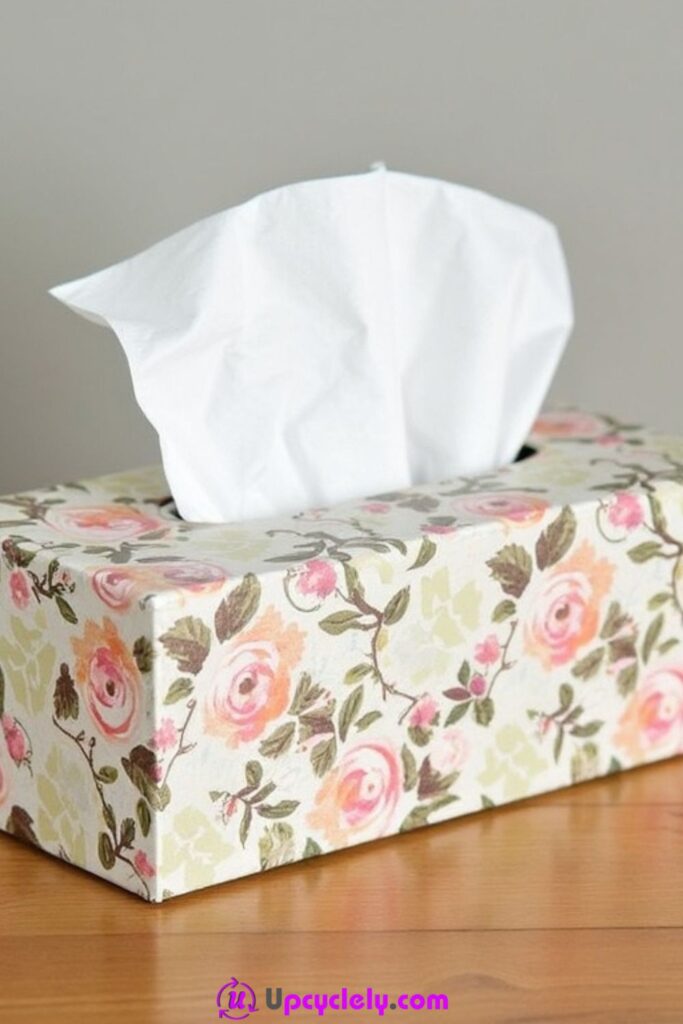
Materials Needed:
- Plain tissue box cover
- Floral or vintage paper
- Scissors
- Mod Podge or decoupage glue
- Paintbrush
Step 1: Prepare the Tissue Box Cover
Make sure the tissue box cover is clean and dry. If it’s made of plastic or wood, lightly sand it for better adhesion of the paper.
Step 2: Cut the Paper
Cut your decorative paper into pieces that fit the sides and top of the tissue box cover. Choose a pattern that complements your room decor, such as soft florals or delicate vines.
Step 3: Apply the Paper
Apply a thin layer of decoupage glue to one side of the tissue box cover. Place the paper on top and smooth it down. Continue this process for all the sides and top, trimming the paper as needed to ensure a snug fit.
Step 4: Seal and Dry
Once the paper is applied, brush a layer of decoupage glue over the entire surface to seal it. Let it dry completely. For extra durability, consider applying a clear acrylic sealer.
Pro Tip: You can add a contrasting ribbon or trim around the edges for a polished, custom look.
Decoupage Trays
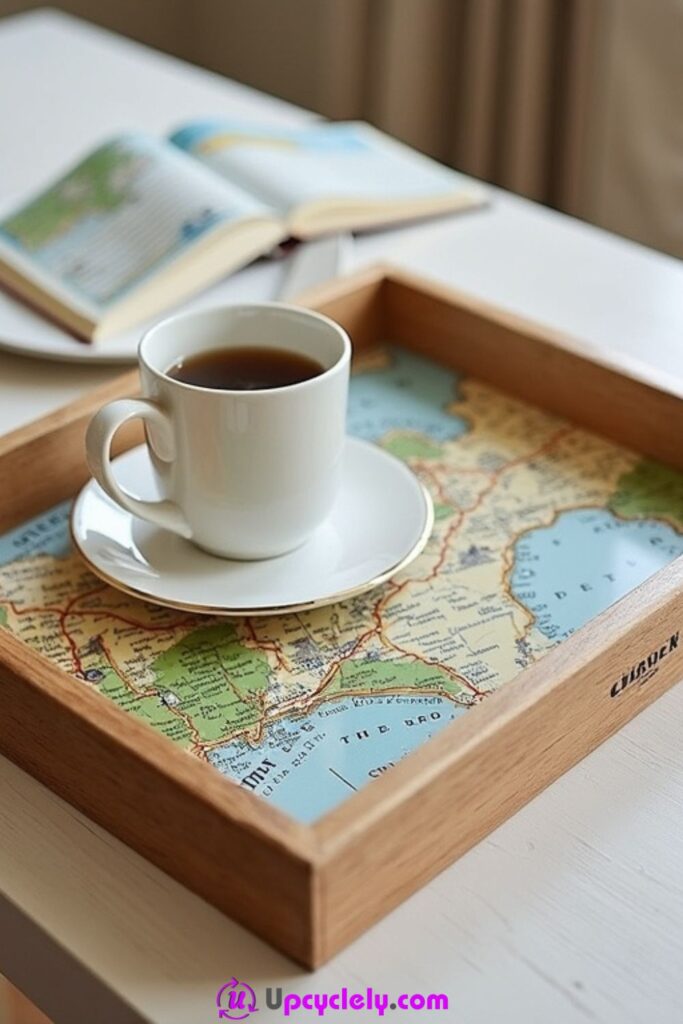
Materials Needed:
- Wooden or plastic tray
- Decorative paper (map patterns, floral designs, or abstract art)
- Scissors
- Mod Podge or decoupage glue
- Paintbrush
- Clear acrylic sealer (optional)
Step 1: Prepare the Tray
Clean the tray thoroughly and sand it if needed to smooth any rough areas. This ensures that the glue adheres well.
Step 2: Cut the Paper
Cut your decorative paper to fit the bottom of the tray. You can opt for large pieces or smaller cut-outs depending on the pattern you’re using.
Step 3: Apply the Paper
Brush a thin layer of decoupage glue onto the tray’s surface. Place the paper on top, smoothing it out to eliminate any air bubbles. Be careful when placing larger sheets of paper to avoid wrinkles.
Step 4: Seal and Finish
Once the paper is in place, apply a layer of decoupage glue on top of the paper to seal it. Allow the tray to dry completely. If desired, finish with a clear acrylic sealer for extra protection and a glossy finish.
Pro Tip: If you’re using a map design, you can personalize it by marking places that are special to you.
Decoupage Wall Art
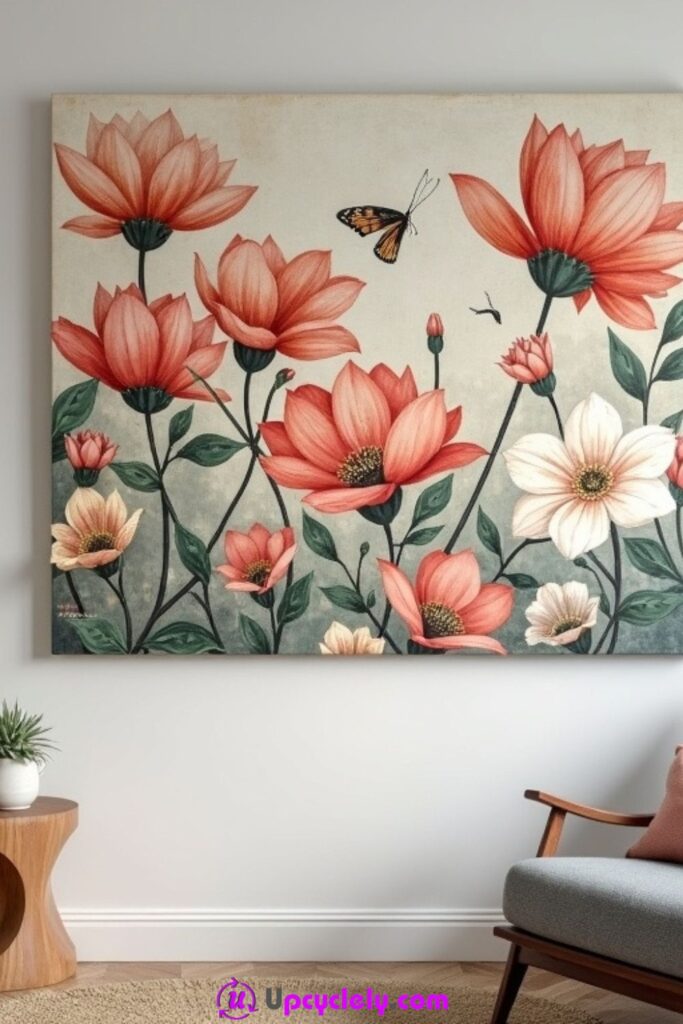
Materials Needed:
- Canvas or wooden panel
- Decorative paper (floral, vintage, or geometric patterns)
- Scissors
- Mod Podge or decoupage glue
- Paintbrush
- Clear acrylic sealer
Step 1: Prepare the Surface
Choose a blank canvas or wooden panel for your wall art. Ensure it’s clean and dry before beginning the decoupage process.
Step 2: Cut the Paper
Cut out the pieces of paper to form your design. This could be a collage of smaller cut-outs or larger sheets that you can overlap to create a layered effect.
Step 3: Apply the Paper
Brush a layer of decoupage glue onto the surface of the canvas or wood. Apply your paper pieces, smoothing them down to ensure there are no wrinkles. You can overlap the pieces for a more dynamic design.
Step 4: Seal and Dry
Once the paper is applied, coat the entire surface with a layer of decoupage glue to seal it. Let the artwork dry completely. If you want a glossy finish, apply a clear acrylic sealer.
Pro Tip: If you want a more textured look, you can use tissue paper or napkins to create a more artistic, layered effect.
Decoupage Wall Clocks

Materials Needed:
- Plain wall clock with a removable face
- Vintage paper (posters, advertisements, or travel-themed designs)
- Scissors
- Mod Podge or decoupage glue
- Paintbrush
Step 1: Remove the Clock Face
Start by carefully removing the clock hands and the clock face. This will allow you to work on just the surface without damaging the clock mechanism.
Step 2: Cut the Paper
Cut your vintage or poster paper to fit the circular face of the clock. Ensure the design fits well and lines up nicely, especially if you’re using multiple images.
Step 3: Apply the Paper
Brush a layer of decoupage glue onto the clock face. Place your paper carefully, smoothing out any wrinkles. Trim any excess paper from the edges.
Step 4: Seal and Reassemble
Once the paper is applied and dry, apply a final coat of decoupage glue to seal it. Let it dry completely before reassembling the clock by attaching the clock hands and placing it back on the wall.
Pro Tip: Consider adding a protective layer of clear acrylic sealer to prevent wear from light exposure.
Decoupage Wallet or Purse
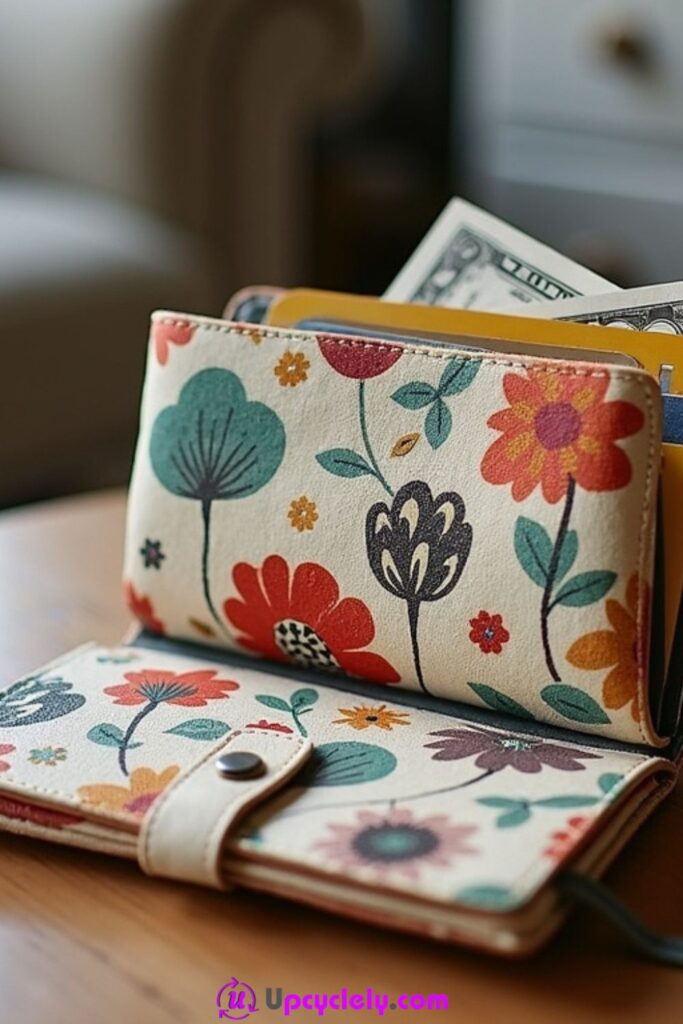
Materials Needed:
- Plain wallet or purse (fabric or leather)
- Colorful floral or patterned paper
- Scissors
- Mod Podge or decoupage glue
- Paintbrush
Step 1: Clean the Wallet
Ensure the wallet or purse is clean and dry before starting. If it’s leather, make sure it’s free of any oils or dirt.
Step 2: Cut the Paper
Cut your decorative paper into pieces that will fit the areas you want to decorate. You can cut it into floral shapes, stripes, or even full sheets for more coverage.
Step 3: Apply the Paper
Brush a thin layer of decoupage glue onto the wallet or purse. Apply the paper, smoothing it down with your fingers to avoid any wrinkles or air bubbles.
Step 4: Seal and Dry
Once the paper is applied, brush another layer of decoupage glue on top of the paper to seal it. Let the purse or wallet dry completely. If you want extra protection, apply a clear acrylic sealer for durability.
Pro Tip: When working with fabric, be sure to use fabric Mod Podge for added flexibility and long-lasting results.

